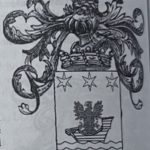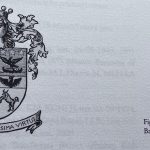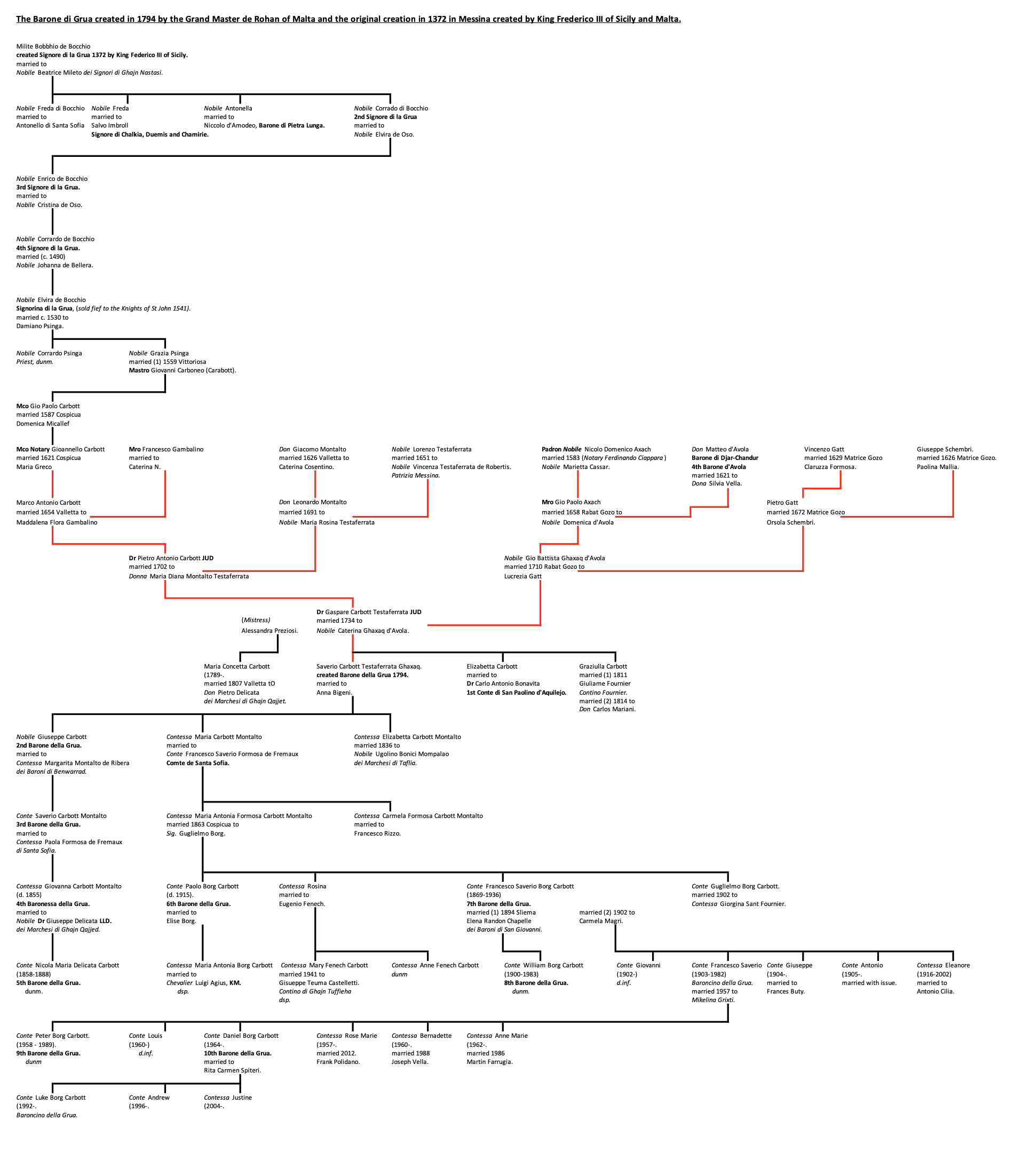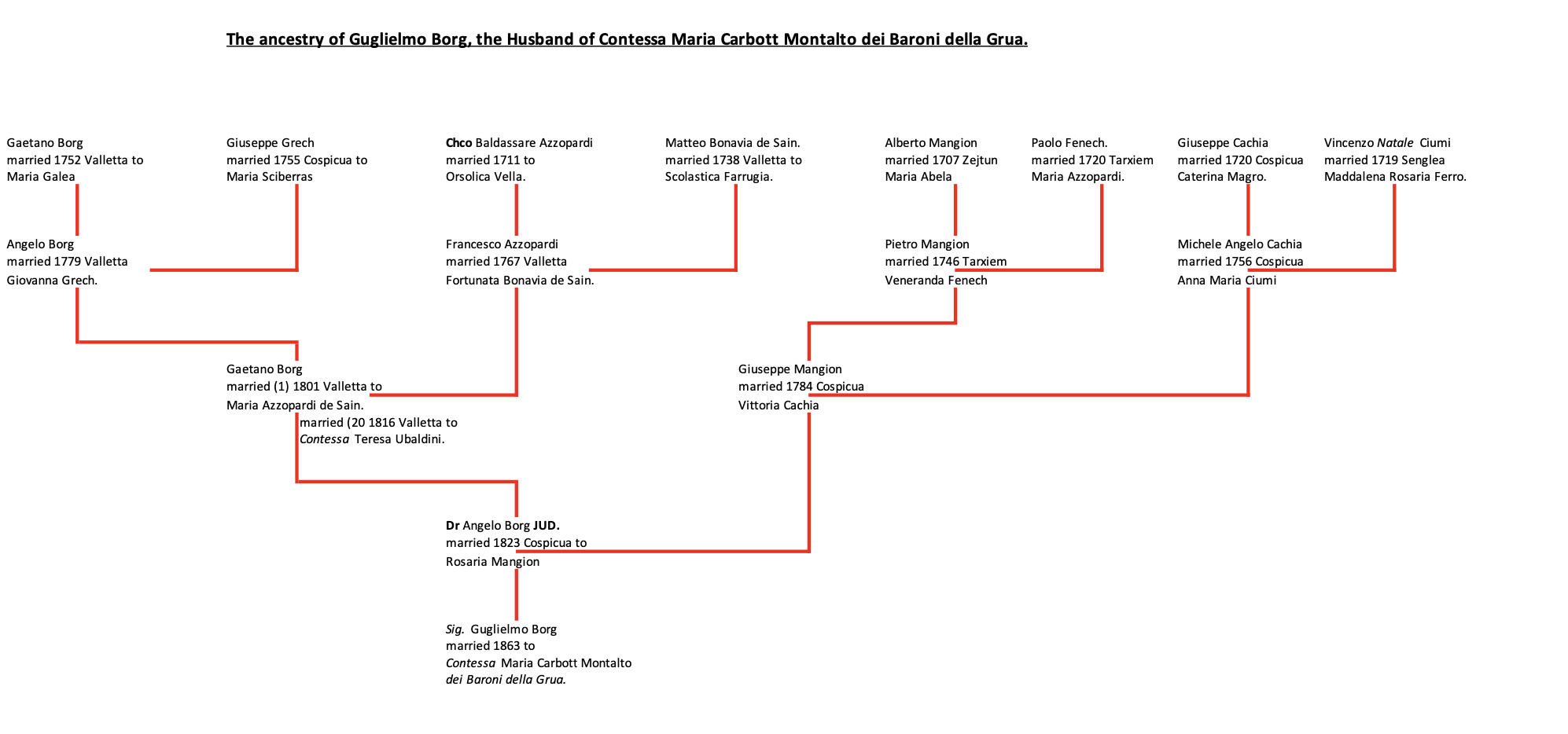Barone di Grua, 1794.
Last Update: 23-11-2025.
Granted to: Magnifico Saverio Carbott Testaferrata Ghaxaq, JUD.
By: Emanuel de Rohan Polduc, Grand Master of Malta.
On: 1794 at Valletta.
British Crown recognition: 1878.
With Remainder to: Grand Master Rohan on the 30th December 1794, issued a diploma conferring the title of Barone della Grua upon the Magnifico Saverio Carbott Testaferrata, and his first-born sons and descendants, under the rule of primogeniture (de primogenitor in primogenito). The following is an extract from the patent of creation: Tibi tuisque filiis et descendentibus masculis de primogenito in primogenitum tribuimus et concedimus et te hujusmodi Baronis titulo decoramus.. That is to say the grant confers the title on the grantee and his male descendants, from firstborn to firstborn By 1878, the male-to-male descending line of the said Saverio was extinct, for Saverio Carbott left Giuseppe Carbott, second Barone, of whom Saverio Carbott Montalto, junior, was born. Saverio Carbott, junior, had no male issue, but only a daughter Giovanna Carbott Montalto, wife of Dr. Giuseppe Delicata, of whom Nicola Maria Delicata was born (see below). See: Correspondence and Report of the Commission appointed to enquire into the claims and grievances of the Maltese Nobility, May 1878, presented to both Houses of Parliament by Command of Her Majesty (C.-2033.).
List of Title holders:
1. Magnifico Saverio Carbott Testaferrata Ghaxaq, JUD, (d. 1837), 1st Barone, succeeded by his son.
2. Nobile Giuseppe Carbott, (d. 1841), 2nd Barone, succeeded by his son.
3. Saverio Carbott, (d. 1843), 3rd Barone, succeeded by his only child, a daughter.
4. Giovanna Carbott Montalto Delicata, (d. 1855), 4th Baronessa, succeeded by her son.
5. Nicola Maria Delicata Carbott dei Marchesi di Ghajn Qajjed, (d. 1888), 5th Barone, succeeded by his second cousin.
6. Paolo Borg Carbott, (d. 1915), 6th Barone, succeeded by his brother.
7. Francesco Saverio Borg Carbott, (d. 1936), 7th Barone, succeeded by his son.
8. William Borg Carbott, (d. 1983), 8th Barone, succeeded by his nephew.
9. Peter Borg Carbott, (d. 1989), 9th Barone, succeeded by his brother.
10. Daniel Borg Carbott, (1964-, 10th Barone.
Heir: Conte Luke Borg Carbott, (1992-, Baroncino di Grua.
Articles relating to this title:
Footnote: This title is purely nominal and does not have any property attached to it. In their general observations, the Royal Commissioners observed that most of the titles granted by the Grandmasters were merely honorary and had no relevance on property tenure “although it appears that those titles (granted by the Grand Masters) have derived their different denominations from several feudal lands existing in these islands, this annexation, however, is in most cases purely nominal, for those lands were never in reality conveyed to the grantees, but they remained as they are still Government Property.” The Commissioners also identified the only three exceptions to this purely nominal phenomenon, where tenure of property was a prerequisite namely Bahria, delle Catene, and Senia, the last being a divisible property. See:- “Correspondence and Report of the Commission appointed to enquire into the claims and grievances of the Maltese Nobility”, May 1878, presented to both Houses of Parliament by Command of Her Majesty (C.-2033.) (See Report Paras. 82).
Published sources show the title of “Barone della Grua” as being inheritable by males and females. In fact Giovanna Carbott Montalto (died 1855) is many times referred to as having held this title. This is not in accordance with the grant.
It is noteworthy that the Royal Commissioners (in their supplemental Report) found that although the title cannot be held by a female, it remains inheritable through a female line.
See:- “Correspondence and Report of the Commission appointed to enquire into the claims and grievances of the Maltese Nobility”, May 1878, presented to both Houses of Parliament by Command of Her Majesty (C.-2033.) (See Report Paras. 76-77; Supplemental Report Part I).
The actual report says the following:
“The same Grand Master Rohan on the 30th December 1794 issued a diploma conferring the title of ‘Barone dellaGrua’ upon the ‘Magnifico Saverio Carbott Testaferrata’, and his first-born sons and descendants, under the rule of primogeniture (de primogenitor in primogenito). The following is an extract form the patent of creation: ‘Tibituisque filiis et descendentibus masculis de primogenito in primogenitum tribuimus et concedimus et te hujusmodiBaronis titulo decoramus’.
The claimant of the present title, Nicola Maria Delicata, who is styled in the committee list as Nicola Maria Delicata Carbott Asciack, descends lineally from the original grantee Saverio Carbott, as appears from the document he has forwarded to us through the committee.
We must, however, state that the male descending line of the said Saverio is extinct, for Saverio Carbott left Giuseppe Carbott, seond Barone, of whom Saverio Carbott Montalto, junior, was born. Saverio Carbott, junior, had no male issue, but only a daughter Giovanna Carbott Montalto, the claimant’s mother. The instructions conveyed to us by the letter of the 8th March 1877, do not require us to determine the question whether a grant made to the male issue of a person is to be taken to extend to the sons of female descendants.”
This question having been reserved to the British Secretary of State for the Colonies, the Commissioners did not include the claimant’s name in the list. The Secretary of State for the Colonies then wrote to Governor Straubanzee to ask the Commissioners to address this issue.
In their Supplemental Report, the Commissioners described as follows, the circumstances where it is permissible for a title to be transmitted through a female line, as well as those circumstances where such transmission through a female line is disallowed:
“The title and dignity of ‘Barone della Grua’ was, as already stated in our former report, conferred on the 30th of December 1794, by Grand Master De Rohan, upon Saverio Carbott Testaferrata, with succession to his sons and male descendants, from firstborn to firstborn. The operative clause of the patent of creation is as follows: – ‘Tibituisque filiis et descendentibus masculis de primogenito in primogenitum tribuimus et concedimus ‘”’.et tehujusmodi Baronis titulo decoramus’The Barone Saverio Carbott, left on his death his son Giuseppe, on whose decease the title devolved upon Saverio Carbott, who had no male issue, but only a daughter Giovanna, wife of Dr. Giuseppe Delicata, of whom Nicola Maria Delicata, the present claimant, was born.
The question involved in this claim is whether the son of a female descendant is called to the succession of a title originally conferred on one of his ancestors and his male descendants, from firstborn to firstborn, or, on the contrary, the title is determined by the extinction of the grantees male line. With reference to that question, we beg to submit that it is a settled point of jurisprudence that the appellation of male descendants includes not only the sons issuing from the male line (masculi ex masculis), but also those issuing from the female line (masculi ex foeminis), when, however, some other expression occurs in the deed of grant which controls the meaning of that term, as for instance when the grantor limits his grant to such among his male descendants as should belong to the male line (descendentes masculi ex linea masculina);, or when he employs other words which clearly show that he contemplated the grantees agnatio, in such case, the effect of the disposition is limited to the male line, and on the failure of males issuing from that line the grant becomes extinct, the male issue of daughters not being called into succession.
In the present case, the order of succession settled in the charter granting the title in question includes generally the grantee’s male descendants, and therefore taking the law relative to the transmission of lands (primogeniture) to be applicable to the transmission of titles, that charter comprehends the claimant who is descended from the grantee through a female line. We are consequently of the opinion that the said Nicola Maria Delicata has established his claim, and that he is to be included in the list of titled gentlemen appended to our former report and styled “Nicola Maria Delicata Barone della Grua”. If the Maltese Nobility are to rank inter se according to the date of their patent of creation, as provided by the decree issued by Grand Master De Rohan in 1795, the claimant is to take precedence immediately after Felicissimo Apap “Marchese di Gnien Is-Sultan”.”
It is therefore clear that the 1794 grant (and the Commissioners report) excludes the possibility of a female coming to hold this title.
* Title of Baron of Grua.
HISTORY
The title Barone della Grua is a title of Nobility in Malta. It was granted in 1794 by the penultimate Grandmaster of the Order of Saint John during its rule over the Maltese Islands. Succession to this title is according to the general rule of Primogeniture but in this case the rule is varied as the title may only be held by males.
Since 1975, a general duty is imposed in the Republic of Malta not to recognize any title of nobility.
ORIGIN AND NATURE OF TITLE
The title of Barone della Grua was conferred by Grand Master Rohan on the 30th December 1794 upon the Magnifico Saverio Carbott Testaferrata, and his first-born sons and descendants, under the rule of primogeniture (de primogenitor in primogenito). The following is an extract form the patent of creation: ‘Tibi tuisque filiis et descendentibus masculis de primogenito in primogenitum tribuimus et concedimus et te hujusmodi Baronis titulo decoramus’.
No land was attached to this title of nobility. The title was merely honorific and did not give rise to any right of possession of the land called Grua.
Some publications show Giovanna Carbott Montalto, wife of Giuseppe Delicata, as having succeeded this title as “4th Baroness”. This lady is neither counted nor included here because the creation in favour of Saverio Carbott does not comprehend any remainder in favour of females.
Grand Master Rohan is also credited with codifying various laws in Malta. Amongst these, we find in the Code enacted in 1783 which states that the determining criteria of primogeniture in Malta operate in the following order:- Line (the first line excluding all the others), Degree (the closer degree of relationship excluding the remoter) Sex (the male sex being preferred to the female), and Age (the elder being preferred to the younger). However, in regard to the title of Barone della Grua succession is not by regular primogeniture but “masculis de primogenito in primogenitum”.
PRECEDENCE ENJOYED BY THE HOLDER OF THE TITLE OF BARONE DELLA GRUA
In terms of the general 1739 legislation it follows that in 1794 all of Saverio Carbott Testaferrata’s male-to-male descendants (“Il discendente per linea mascolina”) were made automatically entitled to a precedence.
By virtue of the later general legislation of 1795 the Barone della Gruaand his agnate descendants were to rank before the holder of any title created after 1794 and respective descendants. Therefore, it follows that the Barone della Grua ranks before the Marchese di Ghajn Kajet (1796) even though all the latter title purports a higher rank. The same position holds in regard to the respective male-to-male descendants. Conversely, the Barone della Grua ranks after the older creations (mostly barons) and the holders of noble fiefs.
THE ROYAL COMMISSION APPOINTED TO ENQUIRE INTO THE CLAIMS OF THE MALTESE NOBILITY
After the Capitulation of the Order of Saint John the new French Rulers formally abolished all titles of nobility. A total of 3 general orders were made to this effect. The French in turn lost Malta in 1800 when the Commander in Chief Vaubois surrendered to His Britannic Majesty. On the 30 May 1814 (Treaty of Paris) it was stipulated that the island of Malta and its dependencies belong in full right and sovereignty to his Britannic majesty.
In time, the use of nobiliary titles was resumed. However, it appears that the unregulated and improper use of titles of nobility and other honours was tolerated by the local authorities who were themselves found to be at fault for encouraging such improper use. Throughout this period, a group known as the Assembly of Maltese Nobles is known to have functioned at this time but it did not enjoy any official role.
In 1876, the British Secretary of State for the Colonies commissioned a report on those titles alleged to have been conferred to Maltese families before the annexation of Malta to the British Dominions, namely 1800. The Commissioners’ Report and Supplemental Report were published in 1878 together with relative correspondence.
To facilitate the preparation of the report, an “ad hoc” Committee of Nobles was requested to provide a list of claimants. In that list, Nicola Maria Delicata is listed with the title of “Barone della Grua”. This listing is at variance with that published in 1870 by the Marchese Giorgio Crispo Barbaro in his “Maltese Nobility and the Maltese Gentry holding Foreign Titles” which does not include any reference to the title of Barone della Grua, implying that it was extinct.
COMMISSIONERS’ INITIAL DIFFICULTY WITH CLAIM OF NICOLA MARIA DELICATA, A MALE DESCENDING IN THE FEMALE LINE FROM SAVERIO CARBOTT TESTAFERRATA
Delicata explained that he descended lineally from the original grantee Saverio Carbott. In fact the Barone Saverio Carbott, left on his death his son Giuseppe, on whose decease the title devolved upon Saverio Carbott, who had no male issue, but only a daughter Giovanna, wife of Dr. Giuseppe Delicata, of whom Nicola Maria Delicata was born.
However, the Commissioners felt that the instructions of the British Secretary of State for the Colonies did not require them to determine the question whether a grant made to the male issue of a person is to be taken to extend to the sons of female descendants.
For this reason only, Delicata’s name did not feature on the list of title holders approved by the Commissioners.
COMMISSIONERS’ SUPPLEMENTAL REPORT CONFIRMING SUCCESSION IN FAVOUR OF DELICATA
Upon receiving these news, the British Secretary of State for the Colonies asked the Commissioners to look into this matter. The Commissioners then proceeded to make a Supplemental Report.
The Commissioners succinctly described the question as whether the son of a female descendant is called to the succession of a title originally conferred on one of his ancestors and his male descendants, from firstborn to firstborn, or, on the contrary, the title is determined by the extinction of the grantee’s male line.
The Commissioners explained that in the present case, the order of succession settled in the charter granting the title in question includes generally the grantee’s male descendants, and therefore taking the law relative to the transmission of lands (primogeniture) to be applicable to the transmission of titles, that charter comprehends the claimant who is descended from the grantee through a female line.
In arriving at this conclusion, the Commissioners took a settled point of jurisprudence that the appellation of male descendants includes not only the sons issuing from the male line (masculi ex masculis), but also those issuing from the female line (masculi ex foeminis).
They also explained that the exception to this rule occurs when some other expression occurs in the deed of grant which controls the meaning of that term, as for instance when the grantor limits his grant to such among his male descendants as should belong to the male line (descendentes masculi ex linea masculina), or when he employs other words which clearly show that he contemplated the grantee’s agnatio.
The Commissioners explained that the effect of a disposition restricting to the male line, meant that on the failure of males issuing from that line the grant becomes extinct because the male issue of daughters are not called into succession.
In the present case, the diploma creating the title of Barone della Grua provided Tibi tuisque filiis et descendentibus masculis de primogenito in primogenitum tribuimus et concedimus et te hujusmodi Baronis titulo decoramus. The Commissioners therefore found no reason to deny the grantee’s primogenial descendant, albeit descended in the female line.
CONTROVERSIES
Nicola Maria Delicata was a male descending in the female line. Some publications show Nicola as having succeeded his mother (i.e. a female) in this title. However, this view does not find any basis in the Commissioners’ findings. In fact neither the original Report nor the Supplemental Report implies that a female is entitled to succeed the title of Barone della Grua as granted in 1794. The diploma creating the title only provides for a remainder in favour of Carbott Testaferrata’s descendentibus masculis. The same Commissioners had already pointed out in their findings on the 1775 creation of “Barone della Marsa” that where only males are contemplated by the grant one cannot extend these terms to include females.
OTHER ENTITLEMENTS
For the purposes of precedence amongst the Nobility in Malta, this title ranks according to antiquity of creation. According to the 1878 Report, this title was considered before the title of Conte della Senia granted by Grand Master Rohan to Vincenzo Fontani on the 6 June 1795 and after the title of Marchese di Gnien Is-Sultan granted by the same Grand Master to Filippo Apap on the 1 December 1792.
The limited use of the title “The Most Illustrious and Noble” was first regulated in Malta in 1725 and was extended by the Grand Masters to only some families, not necessarily titled-families. However, this title was considered unacceptable to the British authorities who opined it could only be borne by Princes of the blood Royal. A compromise was reached allowing the introduction of the style “The Most Noble” on the premise that all title holders were entitled to the title. Thus, as from the year 1886, the holder of the title of Barone della Grua became entitled to be styled “The Most Noble”.
The British Colonial administration also allowed presumed successors of titles of nobility, the diminutive style of their respective titles, in this case Baroncino della Grua. But the Colonial administration did not allow any legal right to the use of these styles.
Other descendants of the various holders of this title are by custom entitled to be styled dei Baroni della Grua. Again, the Colonial administration did not allow any legal right to the use of this style.
PRESENT DAY
Since 1975, a general duty is imposed in the Republic of Malta not to recognize any title of nobility. (Act 29 of 1975 dated 17 October 1975).
REFERENCES
1. Grant of title of Barone della Grua by Grand Master Rohan to Saverio Carbott Testaferrata on the 30 December 1794. (Recorded in the Archives of the Order, National Library, Malta Ref. AOM 617, ff. 135r).




